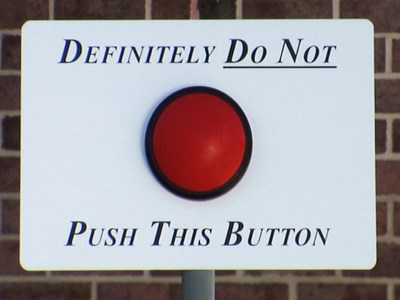
Do not read this blog
Psychology of opposite in comms
Don’t touch that. Don’t go there. Blimey, how many times have I been told “Don’t look now, but…” and subsequently stared at whatever I have been instructed to categorically avoid staring at.
During a recent commute, I noticed an advert for Dave that featured a simple flowchart – ‘Should I try and start a conversation on the train ⇒ No’. This instruction actually had the reverse affect as two people sat next to me started chatting about this amusing instruction. Doing what the ad had told them not to.
Insubordination? Nope, it’s just human nature.
Stop reading
Reverse psychology has always interested me. Getting someone to do what you want by pretending not to want it or pretending to want something else. To go social-science-y for a sec, this idea is largely tied in with the Reactance Theory. A psychological angle suggesting that people who feel their sense of control is being taken away from them will grab it back simply by not doing what they’re asked. Target audiences of course tend to be aware of what’s happening but will respond in the desired way anyway.
One of the best examples I saw of this working at my last agency was Karmarama’s 2016 Don’t Join The Army campaign instructing a target Gen Z audience not to better themselves by joining up.
And most of us are familiar with Nestlé’s controversial ‘It’s Not For Girls’ campaign. Which still drove sales up by 30%, even though the product was banned in some stores. But hey, there’s no such thing as bad publicity, right?
Seriously, stop reading
Capitalising on psychological principles isn’t anything new. But for ‘reverse psychology marketing’ to cut through in a noisy digital market, often daring ideas are required. You still need to stick to some key rules. Ensuring messaging is mechanistic, persuasive, projective and suggestive, but also make sure that it’s somehow flipped on its head. The approach relies on a consumer forming an emotional response to the creativity of an advert, and not just an empathetic attachment to the message itself. They need to feel like the brand they’re engaging with is somehow ahead of the game – breaking the mould and being unconventional. This rebellious approach should then feed through to a consumer’s reaction and bam, your campaign has worked.
I said stop reading
As a more recent example, the Canadian launch of Takis in a fiercely competitive snack market took the brave step of actively telling people not to eat them, using their selling points as reasons to stay away. To go all history-y for a sec, advertising exec Rosser Reeves who coined the term ‘unique selling proposition’ in the early 20th century suggested that the use of anti-marketing sentiments could give companies a competitive advantage. And it seems he was right.
It’s good to provoke engagement in an unconventional way. And depending on what you’re looking to achieve, it can also be used as more than a gimmick to increase sales, but could be used to promote a deeper message like Patagonia’s stand against consumerism from 2011.
It’s pretty simple really – people like their freedom. If they feel rules imposed on them are too strict, or too restrictive, they often break them. A perfect opportunity for any brand, so long as they have the creative nous to make it work.
You read to the end
You’ve proved my point. I like you.
To talk to us about the power of subtle persuasion, DO NOT send us an email saying:. ‘I don’t expect a reply’ here.